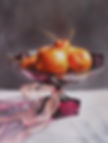More about that "Grisaille" layer!
- vreelandwest
- Apr 27, 2022
- 3 min read
Updated: Apr 18, 2023
(April 27, 2022) A few days ago, I was writing a review of this week's session for my current watercolor students (at the NM Art League), where I'm teaching a still-life & floral class. As I was writing, it occurred to me that this might make an interesting blog entry for my web-site. Here, in part, is what I shared with my students:
As you know, I like to continually emphasize the fact that painting "en Grisaille" (with a "gray layer") is sooooo important for laying the foundation of EVERYTHING in a painting. I guess I’ve “kinda” used a grisaille my entire life (though I didn't realize that as a child). When I was about 7 years old, I discovered “shading.” I drew with my pencils EVERY day, and found that my drawings took on extra life — really “extra dimension” — when I added shading. I also began to add shading to the drawings in my color books … with crayons. I would use a darker crayon, gray, black, brown, or dark blue — and shade-in the "shadow-side" of an object, and then overlay it with color. I loved the way it made the flat color-book drawings look a bit 3D (to my young eyes). By the time I was about 9-10, I was totally in love with the method, and I entered a “color-book-page-Contest” a local toy-store held for ages 12 and younger. (The winner got a free pair of shoes from the shoe-store next-door, and any “toy” they wanted — within a certain price-range — at the color-book-contest-sponsoring toy-store.) I won the contest, and was so elated with my prizes. I also remember my parents asking the shoe-store owner why he picked MY entry, and I overheard him say he had never seen a child use “shading” when coloring in a color-book. So I knew I was onto something there!
All that to say, when I’m working on the grisaille "underpainting" for a watercolor, I often feel like I’ve gone back to my childhood, because all I’m really doing is “SHADING” my object (using a neutral mixed gray watercolor), before adding "pure" color.

At the right you can see what I’m talking about. (From my most recent still-life, "Asian Pears on Amethyst" -- see my "Still-Lifes Gallery.") This is the completed grisaille for this painting.
I’m always very careful to notice where “pure white” or “PURE COLOR” is present in my photo reference. For instance, the pears are a beautiful golden color, with deep red markings and shadows. I didn't paint Grisaille in those areas because if I had, the colors I wanted to glaze there would have never, ever ended up "true." It’s those pure colors (as well as the white of the "raw" paper) that end up adding necessary "brightness" to realism. And yes -- the work done on a grisaille layer is highly detailed, and time-consuming. The goal is for the painting to already appear as a "colorless" image where the realistic scene (or portrait subject) is perfectly represented, and could actually "almost" stand on its own as a black and white.
And as a watercolor instructor, I have to add the following -- hoping none of my readers (aspiring watercolorists?) will take offense. I have seen so many "completed" watercolor paintings where the artist has sadly created a piece using very flat values -- where all the values are the same. Many beginning artists (and some artists who have been painting for many years!) don't understand the importance of saving SOME of the pure white of the paper, insisting on covering every square inch of paper with color or shading. Whenever one of my students does this, I always tell them: "you've killed your painting." (I try to say this with humor and kindness, but I do let them know it's something they need to correct in future paintings.) More and more, I'm having students create a value-scale at the beginning of class. To paint the entire range of values -- from darkest shadows to pure white -- is to create a thing of beauty, and it's essential for realism.
Here below is my finished painting, "Asian Pears on Amethyst." I glazed around 2-3 layers of color over the top of the Grisaille layer, with the final details painted in "dry-brush." For me, this is the only way to paint.

